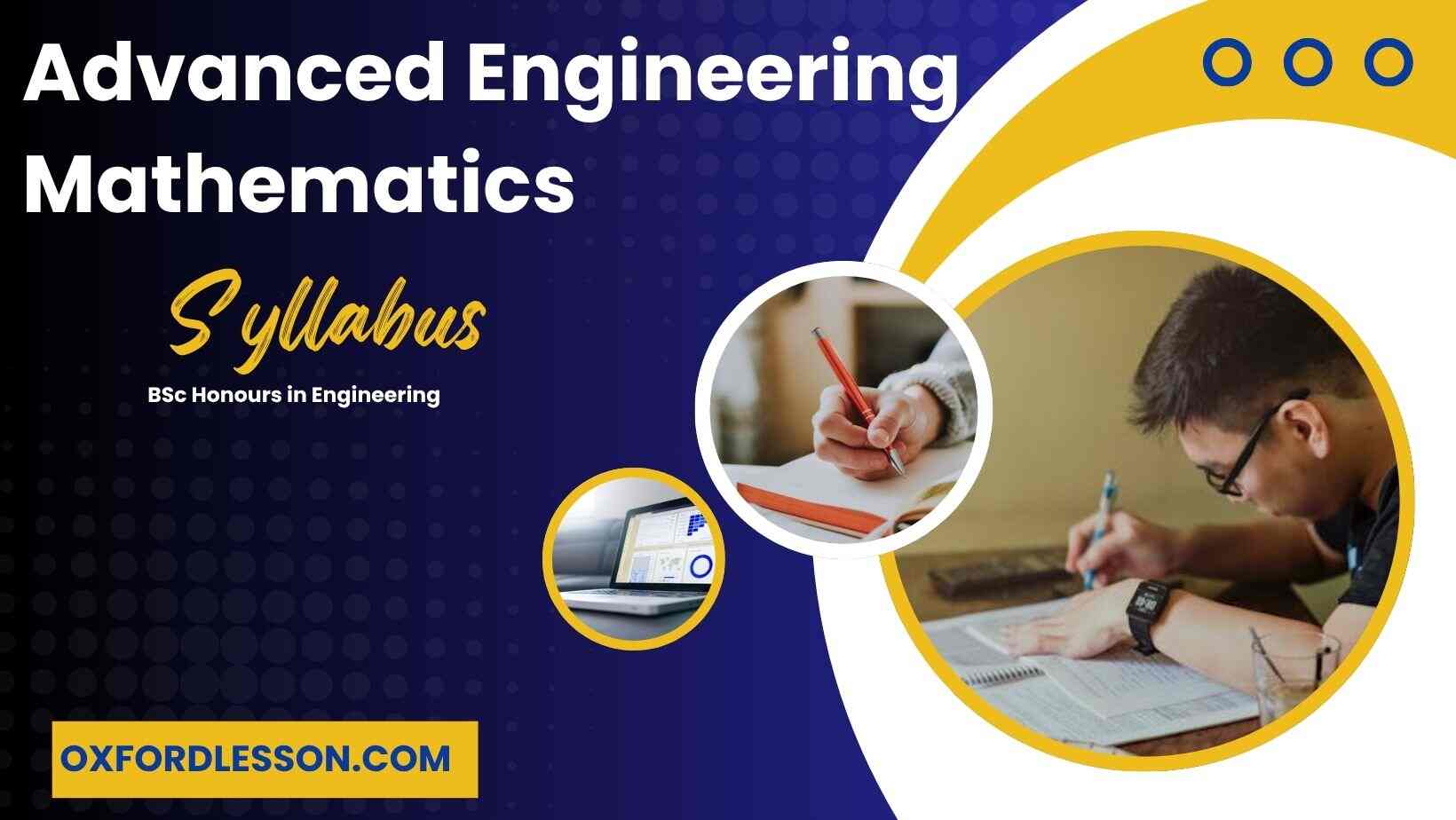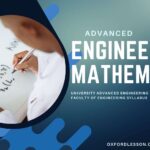I will try to present from this article, advanced engineering mathematics at the university. Did you read my previous article? I read information about the syllabus for the first two years of university. I hope to extend the information from it. You can read information about what are the syllabus of advanced engineering mathematics for the 3rd and 4th years in the engineering faculty.
You can read my previous article from this link. Very important thing you must keep in mind: This syllabus will change a little bit in other universities, but the concepts should be the same. I believe that this is a great article for students and gain knowledge and share this article with your friends. If you have any doubts, comment on me, and I will help you clarify your problem as an undergraduate engineering student.
Third year- Advanced engineering mathematics
| Lessons | Concepts |
| Continuity and Differentiability of Functions of Several Variables | · Functions Defined On Rn Limits and Continuity · Partial Derivatives, Differentiability and Gradients · Derivatives of Higher Order, Equality of Mixed Partials · Chain Rule for Functions of Several Variables |
| Implicit Functions AndJacobian Determinant | · Implicit Functions · Jacobian Determinant |
| Theorems on Several Variables and Applications | · Mean Value Theorem and Taylor’s Formula · Applications of Differentiation of several variables |
| Vector Calculus | · Scalar Field and Vector Field · Differentiation of Scalar Field & Vector Fields · The Scalar Line Integral |
| Analytic Functions | · A Review of Complex Numbers · Analyticity on Complex Plane |
| Elementary Functions of Complex Variables | · Exponential and Logarithmic functions · Trigonometric and Hyperbolic Functions |
| Complex Integrals | · Line Integrals · Cauchy’s Integral Theorems |
| Diagonalization of Matrices and Quadratic Forms | · Hermitian Matrices, Eigen Values and Eigen Vectors, Diagonalization · Linear Transformations of Vector Spaces · Quadratic Forms |
| Vector Spaces And InnerProduct Spaces | · Vector Spaces and Subspaces · Inner product Spaces |
| Statistical Inference AndRegression Analysis | · Parameter estimation and confidence intervals · Hypothesis testing for single and two sample cases |
| Correlation and Regression | · Scatter plot · Least Squares Regression · Principles of Least Squares Regression · The standard error of estimate · Analysis of variance table |
| Statistical Computing | · Application of R Software |
| Application of R Software | · Why learn R? · Installing and Running R · Preliminaries · Basics of the R Language · Sampling Distribution · Point Estimation · Interval Estimation · Hypothesis Testing · Simple Linear Regression |
fourth Year- Advanced engineering mathematics
| Lessons | Concepts |
| Coordinate Systems and Vector Calculus | · Coordinate Systems 1. Coordinates in a Plane 2. Cartesian coordinates 3. Cylindrical polar coordinates 4. Spherical polar coordinates · Scalar Fields, Vector fields and Operators 1. Scalar Fields 2. Vector Fields 3. Operators and Integrals · Integrals with Scalar Fields and Vector Fields 1. Integrals 2. Divergence Theorem 3. Stokes’ Theorem 4. Green’s Theorem |
| Series And Complex Integration | · Series 1. Introduction to Complex Series 2. Tests for Convergence 3. Complex Power Series 4. Taylor Series 5. Singularities 6. Laurent Series · Complex Integration 1. Isolated Singular Point 2. Residues and Poles 3. Application of the Residue Theorem |
| Conformal Mapping | · Conformal Mapping 1. Linear Mapping 2. The Mapping 𝑤 = 𝑧2 3. The Mapping 𝑤 = 1/𝑧 4. Overview of Conformal Mapping · Conformal Mapping Applications 1. Recall 2. Solutions to Dirichlet’s and Menmann Problems by Conformal Mapping 3. Applications to fluid flow 4. Applications to Electrostatics · Bilinear Transformation 1. Bilinear Transformation 2. Cross Ratio 3. Mapping of the Upper-half Plane |
| Fourier Transforms | · Fourier Integral Theorem 1. Fourier Integral Theorem 2. Proof of Fourier Integral Theorem 3. Applications of Fourier Integrals · Fourier Transform 1. Fourier Transform 2. Fourier Sine and Cosine Transforms · Application of Fourier Transform 1. Application of Fourier Transform 2. Application of Fourier Sine Transform 3. Application of Fourier Cosine Transform |
| Tensor Calculus | · Cartesian Tensors 1. Definition of a Cartesian Tensor 2. Notations and Summation Convention 3. Transformation Law of Vectors · Second and Higher Order Tensor 1. Relationships among the Direction Cosines 2. The Kronecker Delta 3. Matrix Notation of the Transformation of a Second Order Tensor 4. Stress Tensor · Algebra of Cartesian Tensors 1. Algebra of Cartesian Tensors 2. Symmetric and Anti-Symmetric Tensors 3. Principal Tensor Axes of Order 2 · The Tensor of Moment of Inertia 1. The Moment of Inertia Tensor 2. The tensor of polarizability 3. The energy ellipsoid 4. Differentiation of Cartesian tensor fields 5. Strain tensor |
| Statistical Methods | · Analysis of Variance (ANOVA) 1. Basic concepts 2. Testing Hypothesis 3. ANOVA table · Design and Analysis of Experiments 1. Principles of experimentation 2. Complete randomized design (CRD) 3. Randomized complete block design (RCBD) 4. Overview of factorial experiments · Overview of Covariance Analysis 1. Role of the Covariate 2. The Covariate as a Regression Variable 3. Steps in ANCOVA · Overview to Quality Control 1. Dimensions of Quality 2. Statistical process control/ (SPC) 3. Control charts · Introduction to Time series analysis 1. Time Series Characteristics 2. Auto regressive models 3. Moving Average Models 4. Partial Autocorrelation Function (PACF) · Statistical Software 1. Design and Analysis of Experiment 2. Analysis of Variance 3. Analysis of Covariance 4. Time Series Analysis |
| Operations Research (Or) | · Introduction to operations research (OR) 1. The History of Operations Research 2. The Methodology of Operations Research · Linear programming 1. Modelling with Linear Programming 2. A linear programming problem in standard form 3. Solution by Simplex Method 4. Tabular form of Simplex method 5. The M method 6. Solution by M method 7. Special cases of LP Problem 8. Degeneracy · Transportation model 1. Applications of transportation model 2. Transportation algorithm 3. Method of finding initial basic feasible solution 4. Checking for optimality · Network model 1. Mathematical model 2. Network Simplex Algorithm · Integer programming 1. Integer programming models 2. Challenge of rounding in integer programming 3. Branch and Bound Method · Software tools for operations research 1. Solving linear programming problems 2. Solving transportation problems 3. Solving integer programming problems |
| Simulations | · Introduction to simulation 1. Mathematical Solutions versus simulation 2. Reasons for using simulation 3. Shortcomings of simulation 4. The simulation process · Simulation techniques 1. Stochastic simulation 2. Monte Carlo Sampling 3. Random variables 4. Simulation of an Inventory system with uncertain demand and reorder lead time 5. Simulation of a Queuing system · Generation of pseudo random variates 1. Pseudo random numbers 2. Congruential method 3. Tausworthe generators 4. The lagged Fibonacci generators 5. Statistical tests for pseudo random number generators · Generation of random variates 1. The inverse transformation method 2. Sampling from continuous time probability distributions 3. Sampling from discrete time probability distributions 4. Sampling from an empirical probability distributions 5. Rejection method · Software tools for simulation 1. Generating random numbers in Excel 2. Solving inventory problems in Excel 3. Solving queuing problems in Excel |
Advanced engineering mathematics is a very powerful tool that is used to change the way one thinks. A great thinking pattern is essential for engineering students. Using this tool, we can make a perfect engineer. Approaching problems and making decisions are important skills for an engineer. Train the brain for structured, disciplined thinking.

